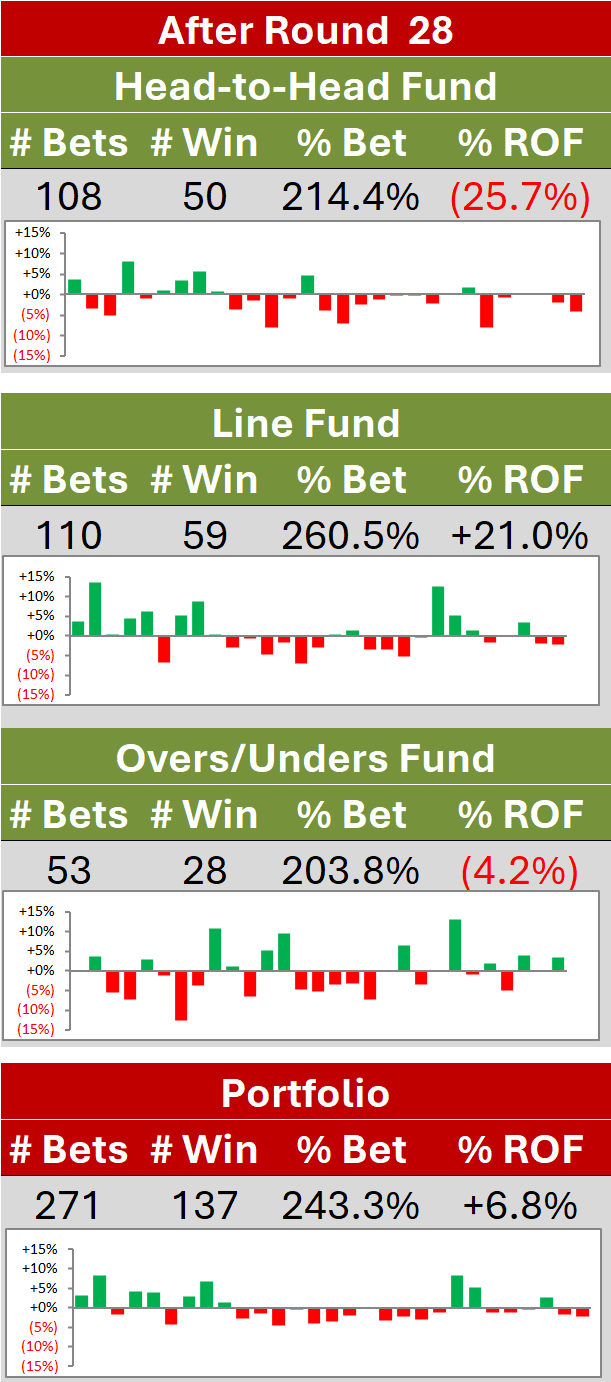2021 : Simulating the Final Ladder After Round 20
/The latest simulations of the home and away ladder appear below. In reviewing them, note that the comparisons to the Round 19 simulations include some changes that are related to the late venue changes in that round, which were not included in the simulation results that were published here last week. Those effects should be relatively small.
In any case, this week we find from using the Standard Methodology that we have:
six teams certain to play Finals, one team about a 2-in-3 shot, another about a 2-in-5 shot, four more teams with about 1-in-6 to 1-in-3 chances, and one team with a 1-in-25 chance
three teams with about 19-in-20 to 99-in-100 shots at the Top 4, one with around 2-in-3 chances, one team with about a 1-in-3 chances, and one with about 1-in-13 chances
Under the Heretical Methodology we have:
six teams certain to play Finals, one team about a 3-in-5 shot, another about a 9-in-20 shot, four more teams with about 1-in-6 to 1-in-3 chances, and one team with a 1-in-20 chance
three teams with about 19-in-20 to 99-in-100 shots at the Top 4, one with around 2-in-3 chances, one team with about a 1-in-3 chances, and one with about 1-in-13 chances
As we would expect, the Standard and Heretical Methodologies become more similar as the season nears its end.
(For details about the methodologies I’ve used, see this earlier blog. Note that I have assumed no change in fixturing for the remainder of the season except for switching the future Swans v Saints game to be a home game for the Saints)
LADDER FINISHES
Team Expected Wins under the Standard Methodology grew by 0.7 wins this week for Hawthorn, and fell by 0.7 wins for Brisbane Lions.
The big moves in terms of Finals chances were Fremantle’s doubling by 21% points to 42%, and Carlton’s increase by 12% points, but only to 16%.
In Top 4 chances we saw Port Adelaide’s increase by 16% points to 67%, and Brisbane Lions’ decrease by 36% points to 8%.
According to both the Standard and the Heretical Methodology, the Dogs are now around 50% chances for the Minor Premiership, the Cats around 30%, and the Dees around 20%.
STANDARD METHODOLOGY
HERETICAL METHODOLOGY
The range of Expected Wins using the Standard Methodology across the 18 teams moved to about 11.7 wins this week, while using the Heretical Methodology it came in at about 11.8 wins.
The animation below shows how each team’s ladder probabilities have varied across the season so far.
Here’s that same data presented as stacked 100 percent bars in a format that I still don’t think has a name.
Across the 50,000 Standard Methodology simulations there are 3,234 different sets of teams playing Finals, treating different orderings of the same eight teams as a different set. No ordering appears in more than 481 replicates. If we ignore ordering, there are still 21 different sets of eight Finalists.
Amongst the teams currently in the Top 8, the estimated probability that any 5 through 8 of them play Finals is:
All 8: 18%
Only 7: 72%
Only 6: 10%
Put another way, there’s about an 82% estimated chance that the teams playing Finals won’t be the current Top 8 teams.
TEAM AND POSITION CONCENTRATION
The HHI figures for the most recent Standard Methodology simulation replicates appear below.
(For information about the HHI, also see that previous blog linked to earlier).
Teams’ final ladder positions are continuing to become less uncertain. This week, for example, saw a 1.9 spot reduction in final ladder position uncertainty for Brisbane Lions, a 1.8 spot reduction for St Kilda, a 1.5 spot reduction for Fremantle, and a 1.4 spot reduction for Collingwood. The only sizeable increases were 0.5 spot increase for Carlton and Hawthorn.
Essendon, Carlton, Richmond, and GWS are now the teams with greatest uncertainty about the positions in which they’ll finish on the ladder, each of them effectively competing now for about 6.5 to 7 different ladder spots. North Melbourne and Brisbane Lions have least uncertainty, with each now effectively competing for only 1.5 to 2 spots.
After 18 rounds, the average team is now effectively competing for about 4.4 different ladder positions.
Most ladder positions again saw decreases in the effective number of teams competing for them last week, with none seeing an increase of more than 0.2 teams. Particularly large decreases in uncertainty were registered by 14th (-1.2), 13th (-1.1), 3rd and 4th (-1.0), and 6th and 18th (-0.9).
Positions 8th through 13th are now the ones that are associated with most uncertainty, and some of the top and tail positions - 1st through 7th, and 17th and 18th - with least uncertainty.
There are now, effectively, about 2.7 teams vying for the Minor Premiership, and 1.6 battling for the Spoon.
IMPORTANCE OF PERCENTAGE
The Standard Methodology simulations suggest that percentages are now slightly more likely to decide 8th spot on the ladder.
There is now an estimated 42% chance that 8th and 9th will finish equal on competition points, a 21% chance that 8th and 10th will, and an 8% chance that 8th and 11th will.
There’s also still about a 31% chance that the double-chance in the Finals will be determined by percentage.
WINS TO MAKE The 8 AND THE 4
Based on the Standard Methodology, St Kilda now are the only team who can reach 11 wins that won’t be at least 80% chances of playing Finals if they do. Twelve wins will be enough to guarantee a spot in the Finals for any team that can reach that tally.
Looking next at making the Top 4, we see that teams’ chances are essential zero for 14 wins, and range from about 20 to 60% for 15 wins, with Port Adelaide, Sydney, and Brisbane Lions having the smallest chances, and Western Bulldogs, Geelong, and Melbourne the greatest.
HOW MANY WINS TO FINISH WHERE
Now a look at what the Standard Methodology shows for the joint distribution of number of wins and final ladder position for each team.
WINS FOR A PARTICULAR LADDER POSITION
And, finally, an update on the distribution of wins associated with each ladder position.
It remains most likely that 11 wins will be associated with the team finishing 8th, but 10 wins is also a genuine possibility. It’s also the case now that 16 wins rather than 15 is most likely to be associated with the team finishing 4th.
GAME IMPORTANCE
Finally, let’s take a look at how the Standard Methodology estimates the importance of each of the remaining 27 games (see this blog for details about how these are calculated).
The table below records the 10 most important games for each of the 7 teams whose Finals fate is not yet determined.
All of them bar St Kilda have games of consequence in Round 21, St Kilda’s being less consequential mostly because of the mathematical unlikelihood of them playing Finals.




